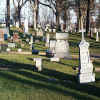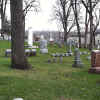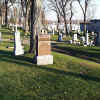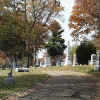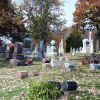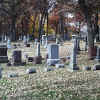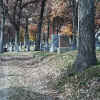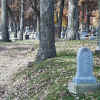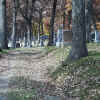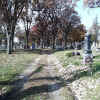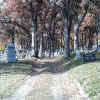| Greenwood Cemetery's history dates back to around 1850. Society has gone through many
changes in the last two centuries, and the American cemetery has gone through changes as
well. Greenwood Cemetery reflects these transformations. Before discussing the history of
Greenwood, an overview of the history of cemeteries in America will first be given. A firm
understanding of the evolution of American cemeteries will provide a context for the
discussion of Greenwood's history. American cemeteries went through three
distinct stages of change, starting about 1831. The “rural” or
“garden” cemetery movement dominated thinking from roughly 1830 to 1855. From
about 1855 to 1920 the “lawn” and “memorial park” cemetery movement
took center stage. After 1920, the "memorial park" style began to emerge with
Los Angeles' Forest Lawn. These movements were critical in the evolution of today's modern
cemetery. Each left impressions on cemeteries across the country, including
Greenwood.
Prior to 1831 urban cemeteries in America were primarily located in churchyards, at or
near the center of the city or town. Since the beginnings of settlement in New England the
standard places of burial had been amid the living, in the middle of towns, in churchyards
or in churches, a practice which in England dated back to the 8th
century.[1] Churchyard
cemeteries were not only characteristic of New England, but were found all along the
Atlantic coast.
Before 1830 most cemeteries were not viewed in the same manner as today. Today,
cemeteries are seen as a peaceful place of internment around trees and lawns. This was not
the case in early American history. Cemeteries were simply treated as unattractive
necessities to be avoided as much as possible.[2] Cemeteries prior to 1831 were often
neglected and overgrown with weeds. This phenomenon was evident in the history of
Greenwood Cemetery as well. In the early days of Greenwood Cemetery, there was no regular
sexton, but patrons cared for their own family lots, a good many maintaining fences around
them to keep cattle from trampling the graves.[3]
As the years passed churchyards and burial grounds became overcrowded. Overcrowding
brought with it many problems. Many times cities would just build over the graveyards as
if they were not even there, in order to serve the needs of a growing population. Because
of the rapidly increasing population the old cemeteries became so crowded that they were
frequently little more than stinking quagmires—chronically offensive and often
serious public health hazards.[4] More than just health hazards prompted change in the
American cemetery. As Stanley French states in his essay, “The Cemetery as Cultural
Institution: The Establishment of Mount Auburn and the Rural Cemetery Movement”:
Rapid urban growth and population mobility, booming business and commercial ventures,
aggregations of surplus wealth, concentrations of educated and public-spirited people,
revisions of religious doctrines, Romantic affection of Nature—all combined to create
a context in which the rural cemetery was a logical alternative to the burial places of an
earlier era.[5] With numerous complaints about the revolting state of churchyards, a new
place of burial was needed.
Changes in cemetery layout and structure began in New England, around Boston. These
changes spread across the country, and the impact and influence of the rural cemetery
movement are visible in cemeteries across the country. The rural cemetery was the answer
society was looking for. The rural cemetery movement is recognized as the first stage in
the evolution of the modern cemetery. Promoters of the rural cemetery movement wanted to
change the horrible image cemeteries had received over the years, and replace it with an
image of peacefulness surrounded by nature. A new appreciation of nature began. People
began to see nature as something to be enjoyed as well as tamed. In 1831, Mount Auburn
Cemetery was established in Cambridge, Massachusetts. Mount Auburn is recognized as the
first rural cemetery in America, and an example which cemeteries across the nation began
to follow. Its creation marked a change in the prevailing attitudes about death and
burial.[6] Mount Auburn was a new type of burial place designed not only to be a decent
place of internment, but also to serve as a cultural institution.[7] |
